Policy Key Points
This policy aims to prevent accidental release of energy that could result in injury to associates by establishing procedures for locking out and tagging out equipment during maintenance or servicing.
Only authorized associates may apply locks and tags in accordance with this program.
Lockout / Tagout Roles
Authorized Associate: A person who locks out or tags out machines or equipment to perform servicing or maintenance.
Affected Associate: An employee who operates or works near equipment undergoing lockout/tagout.
Other Associate: Any employee or contractor who may be in an area where energy control procedures are used.
Preparation:
- Develop written lockout procedures for each machine, considering all energy sources (electrical, mechanical, hydraulic, etc.).
- Machines that can be fully locked out by unplugging do not require a written procedure if the plug remains under the exclusive control of the associate performing the work.
Lockout / Tagout Sequence of Procedures
- Notify all affected employees of the lockout/tagout operation.
- Shut down equipment using normal procedures.
- Isolate equipment from all energy sources and dissipate any stored energy.
- Apply lockout devices and attach identification tags.
- Confirm that the equipment is de-energized and that the lockout is effective before starting work.
- Use appropriate testing equipment and follow safety protocols.
- If testing or repositioning is required, follow specific procedures to temporarily remove lockout devices, perform the test, and then reapply the lockout.
Group Lockout
When multiple associates are involved, each must apply their own lock and tag to the energy-isolating device.
Use a multiple-lock hasp if the device cannot accept multiple locks.
Shift Changes
Use a multiple-lock hasp to transfer lockout between shifts.
Incoming associates apply their locks before outgoing associates remove theirs.
Emergency Lockout Removal
A manager verifies the absent authorized associate is not at the facility.
The manager oversees the removal of the lockout device by another authorized associate.
The absent associate is informed that their lock was removed before they resume work.
Policy
Overview
Definitions
Responsibilities
Lockout Tagout Process
Group Lockout
Shift Changes
Emergency Lockout Removal
Training Requirements
Audits
Records
Overview
Purpose of this Policy
This program is designed to protect against the inadvertent or unintended release of energy, movement, or flow in electrical, mechanical, or material systems, which could result in injury to Yaskawa associates.
Lockout of these systems must be utilized, where needed, to safely allow entrance into or close contact with equipment.
These procedures will be used to ensure that machines or equipment being inspected, serviced or maintained are isolated from all potentially hazardous energy and locked out before Yaskawa associates perform any activities where unexpected energizing, start up, or release of stored energy could cause injury.
Scope of this Policy
All Yaskawa associates and contractors will comply with the requirements of this program. Only authorized Yaskawa associates may apply locks and tags and only in accordance with this program.
Back to Top
Definitions
Affected Associate
An employee whose job required him/her to operate or use a machine or piece of equipment on which servicing or maintenance is being performed under lockout or tagout, or whose job requires him/her to work in an area in which such servicing or maintenance is being performed.
Authorized Associate
A person who locks out or tags out machines or equipment in order to perform servicing or maintenance on that machine or equipment. An affected employee becomes an authorized employee when that employee's duties include performing servicing or maintenance covered by this policy.
NOTE: An associate or contractor may be authorized in one area, such as production, and only affected in other areas, such as laboratories. Authorization is determined by the location and type of equipment being worked on.
Other Associate
An employee or contractor who may be in an area where energy control procedures may be utilized.
Capable of Being Locked Out
An energy-isolating device is considered capable of being locked out if it:
- Is designed with a hasp or other means of attachment to which a lock can be affixed. or
- Has a locking mechanism built into it. or
- Can be locked without dismantling, rebuilding, or replacing the energy-isolating device or permanently altering its energy control capability.
Energized
Machines and equipment are energized when they are connected to an energy source or they contain residual or stored energy.
NOTE: Machines and equipment are considered energized until the absence of energy is verified.
Energy-Isolating Device
A mechanical device that physically prevents the transmission or release of energy, including but not limited to the following:
- Manually operated electrical circuit breaker;
- Disconnect switch;
- Manually operated switch by which the conductors of a circuit can be disconnected from all ungrounded supply conductors and, in addition, no pole can be operated independently;
- Line valve; a block; and any similar device used to block or isolate energy.
Push buttons, selector switches and other control circuit type devices are not energy isolating devices.
Energy Source
Any source of electrical, mechanical, hydraulic (including stored hydraulic pressure in accumulators, etc.), pneumatic, chemical, thermal, gravity/weight of suspended objects, or other energy.
Lockout
The placement of a lockout device on an energy-isolating device, in accordance with an established procedure, ensuring that the energy-isolating device and the equipment being controlled cannot be operated until the lockout device is removed.
Lockout Device
Any device that uses positive means, such as a lock, blank flanges and bolted slip blinds, to hold an energy-isolating device in a safe position, thereby preventing the energizing of machinery or equipment.
Normal Production Operations
Utilization of a machine or equipment to perform its intended production function.
Servicing and/or Maintenance
Workplace activities such as constructing, installing, setting up, adjusting, inspecting, modifying, maintaining and/or servicing machines or equipment, including lubrication, cleaning or unjamming of machines or equipment, and making adjustments or tool changes, where employees could be exposed to the unexpected energization or startup of the equipment or release of hazardous energy.
Tagout
The placement of a tagout device on an energy-isolating device, in accordance with an established procedure, to indicate that the energy-isolating device and the equipment being controlled may not be operated until the tagout device is removed.
Tagout Device
Any prominent warning device, such as a tag and a means of attachment, that can be securely fastened to an energy-isolating device to indicate that the machine or equipment to which it is attached may not be operated until the tagout device is removed.
Back to Top
Responsibilities
EHS Risk Mitigation Manager
- Release of Control of Hazardous Energy Sources Policy
- Annual review and updates (as required) of this Policy
Yaskawa Managers
- Ensure associates receive appropriate levels of training (Authorized, Affected and Other)
- Complete, or coordinate completion of, energy control procedures for affected equipment within areas of responsibility
- Complete annual audit/inspection of each energy control procedure within areas of responsibility
All Yaskawa Associates
- Follow requirements defined within this policy
Back to Top
Lockout Tagout Process
Lockout Tagout Preparation
A carefully sequenced procedure should be developed for the lockout of each potentially hazardous machine. This procedure should be in writing. A copy of the procedure, laminated to protect it from damage, should be kept with the machine.
- Machines and equipment that can be fully locked out by unplugging from the power source does not require a written procedure. The plug must be locked or remain in full control and visibility of the associate performing work.
In preparing this lockout procedure, it is important to consider ALL sources of energy. Almost every machine has an electrical power connection. Many machines have additional sources of energy… hydraulic, air pressure, suspended weights, etc. Each source of energy must be listed, and the procedure for controlling that energy source must be detailed, step by step.
As existing equipment is modified, these procedures should be reviewed and then revised. As new equipment is purchased, lockout procedures should be developed.
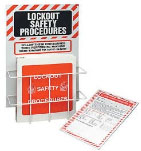
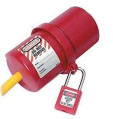
Machine specific instructions should be completed for equipment that has multiple sources of energy or that cannot be locked out by plugging or unplugging.
Example of plug lockout device.
Sequence of Procedures
The Authorized Associate should know before beginning lockout procedures the type, magnitude, and hazards of energy that the machine or equipment utilizes.
Notify all Affected Employees when, where, and why a lockout system is going to be utilized.
Post lockout sign in a visible position on the machine or equipment to be lockout.
If the machine or equipment is operating, shut it down by the normal stopping procedure (depress stop button, open toggle switch, etc.).
Operate the switch, valve, unplug, quick disconnect, or other energy isolating devices so that the equipment is isolated from its energy sources. Stored energy such as springs, elevated machine members, rotating flywheels, hydraulic systems, air, gas, steam, or water pressure, etc. must be dissipated or restrained by methods such as reposition, blocking, bleeding, etc.
Lockout the energy isolating devices with the specially assigned red individual locks. Use yellow cylinder boxes to lock out plugs, quick disconnects, or remote switches. Sign, date, and attach Lockout Identification Tag through the lock pin.
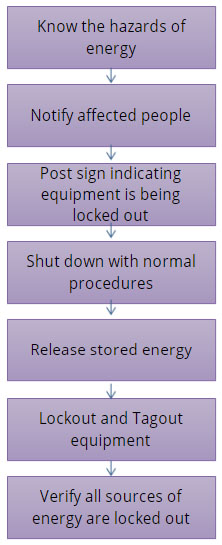
Lockout/Tagout Verification
After ensuring that no Employees are exposed, and as a check on having properly disconnected the energy sources:
- The equipment shall be considered “Energized” until absence of energy if verified.
- If electrical, use a calibrated voltage meter rated for the voltage being checked to ensure no voltage is present using the following procedure:
- Using proper PPE according to the Shock and Arc flash rating label on the equipment, or NFPA 70E tables in the absence of the label:
- Use a known, energized source to verify the meter is working properly,
-
- Check power input sources on the equipment and verify there is zero voltage,
- Check potential stored energy sources, such as capacitors, and properly discharge any stored energy,
- Verify absence of stored voltage,
- Return to the known, energized source and verify meter is working properly.
Operate the push button or other normal operating controls to make certain that the equipment will not operate. Return operating controls to off or neutral position after test.
Lockout Verification Flowchart
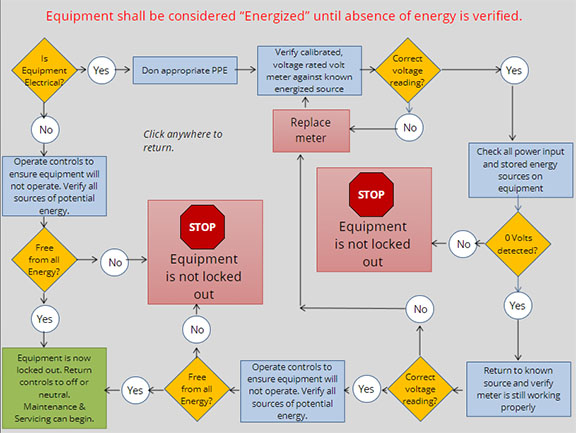
Testing and Positioning of Machines
Inspect the work area to ensure that nonessential tools and material have been removed and to ensure that the machine/equipment components are operationally intact.
Notify and remove Employees from the machine/equipment area.
Remove the lockout devices by the Authorized Employee who applied the device.
Energize and proceed with testing/positioning.
De-energize all systems and reapply energy control measures as outlined in Sequence of Lockout Procedures.
Restoring to Normal Position
After the servicing and maintenance is completed, and the equipment is ready for normal production operations, check the area around the machines or equipment to ensure that no one is exposed to any danger.
After all tools have been removed from the machine or equipment, guards have been reinstalled and Employees are in the clear, the individual applying the lockout device will remove all lockout devices, identification tags, and signs.
Operate the energy isolating devices to restore energy to the machine or equipment.
Back to Top
Group Lockout
If more than one individual is required to lockout equipment, each individual will place their own personal lockout device on the energy isolating devices.
When an energy-isolating device cannot accept multiple locks, a special red multiple lockout hasp will be used.
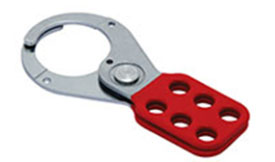
Multiple-Lock Hasp
Back to Top
Shift Changes
A multiple-lock hasp shall be used if work is expected to be transferred between shifts.
The latter authorized associate shall apply her or his lock before the prior associate(s) remove their locks.
Emergency Lockout Removal
The absent Authorized Employee’s Manager must verify that the Authorized Employee who applied the device is not at the facility.
The Manager must be present at the machine/equipment before another Authorized Employee can use the emergency spare key or lock cutter to remove lockout device.
All reasonable effort must be made to contact authorized Employee to inform them that their lockout device has been removed.
The Authorized Employee’s Manager must notify the Authorized Employee(s) before they resume work at the facility that their lockout device has been removed.
Back to Top
Training Requirements
Authorized Associates
The first time a Yaskawa Associate becomes Authorized as a Yaskawa employee, he/she will complete the training with the instructor physically present. Subsequent training can be completed using e-training with instructor access available through email or phone.
This training shall include, as a minimum, the following:
Review of this policy,
- Recognition of hazardous energy sources,
- The types of energy involved (electrical, mechanical, pneumatic, hydraulic, steam, water or other fluids under pressure, thermal, gravity, chemical and gases,
- The magnitude of the energy available in the equipment or machinery,
- The methods used to apply lockout/tagout devices, including the sequence for applying and removing lockout devices, and
- The types of devices that are to be used and where they are to be applied
The first time the associate is qualified as an Authorized Associate as a Yaskawa associate, the associate shall demonstrate the procedure to the instructor.
Authorized Associates are qualified for specific work areas. (e.g. An Authorized Associate in Oak Creek Production is not authorized for Oak Creek Laboratory, unless specifically authorized for Oak Creek Laboratory.)
Retraining is required for the Authorized Associate whenever:
- There is a change in his or her job assignment,
- When a new hazard is introduced due to a change in the equipment, process, or energy control procedures, or
- Inspections reveal inadequacies within the Authorized Associate’s performance of the lockout/tagout procedure.
- The retraining can be e-training as long as the associate has immediate access to a qualified instructor.
Affected Associate
Affected Associates are workers who are affected by lockout/tagout operations in their work area (e.g. machine operator). This training may be conducted via e-training as long as immediate access to an instructor is available to answer questions. (This may be via phone.)
This training shall include, as a minimum, the following:
- The purpose of the Lockout/Tagout program,
- How energy control procedures are used,
- How Affected Associates are notified of lockout/tagout activities,
- Requirement to stay clear of equipment during a service cycle,
- Requirement to refrain from altering, bypassing, or interfering in anyway with lockout/tagout procedures,
- The process for returning control to the affected associate.
Retraining is required for the Authorized Associate whenever:
- There is a change in his or her job assignment,
- When a new hazard is introduced due to a change in the equipment, process, or energy control procedures, or
- Inspections reveal inadequacies within the Affected Associate’s performance of the lockout/tagout procedure.
The retraining can be e-training as long as the associate has immediate access to a qualified instructor.
Other Associates
Each Yaskawa America, Inc. Associate shall receive “Other Associate Lockout/Tagout” training within:
- 90-days from the release of this policy for associates employed on or before the release date, or
- 30-days of employment.
Training for Other Associates shall include:
- Purpose of lockout/tagout procedures,
- Prohibition on tampering with lockout/tagout devices,
- Requirement to stay clear of locked out/tagged out equipment
This training is included within the Yaskawa New Associate Safety Training module.
Electrical Training
Associates working with electricity must be trained in electrical safety-related work practices and must be a “Qualified Worker” within Yaskawa’s electrical safety program.
Back to Top
Lockout Tagout Audits
An annual audit of each energy control procedure must be completed.
This audit shall include a review of each associate’s responsibilities under the energy control procedure being inspected.
Each energy control procedure must be separately inspected at least annually to ensure that the energy control program is being properly utilized.
At a minimum, these inspections must provide for the demonstration of the procedures and must be performed while authorized employees perform servicing and/or maintenance activities on machines or equipment. Specifically, the inspector must be able to determine whether:
- The inspected procedures are adequate,
- They are understood, and
- They are being followed by all associates (Authorized, Affected, and Other).
Records
| Record Title |
Retained by |
Disposition |
| Authorized Associate Training |
Yaskawa Learning Management System |
Employment Tenure plus 5 Years |
| Qualified Associate Training |
Yaskawa Learning Management System |
Employment Tenure plus 5 Years |
| Other Associate Training |
Yaskawa Learning Management System |
Employment Tenure plus 5 Years |
| Machine/Equipment Specific LOTO Procedure |
Kept with Machine/Equipment |
Kept with machine until updated or machine is no longer in facility |
| Energy Control Audits |
Maintained by Cost Center Manager |
Min 5 years |
Revision History
| Rev # |
Description |
Release Date |
Approved by |
| 0 |
Conversion of old safety documents, rewrite, and issue |
5/17/2016 |
Thurwanger |
| 1 |
Reformatting, no substantive changes to content |
9/12/2016 |
Thurwanger |
| 2 |
Added reference to NFPA 70E tables |
12/2/2019 |
Thurwanger |
|
|
|
|
|
|
|
|
|
|
|
|
Program Review
| Review Date |
Reviewed by |
Changes Required (Yes/No) |
Revision # if updated |
| 2/15/2017 |
Thurwanger |
No |
|
| 1/10/2018 |
Thurwanger |
No |
|
| 1/17/2019 |
Thurwanger |
Yes |
2 |
| 1/9/2020 |
Thurwanger |
No |
|
| 1/19/2021 |
Thurwanger |
No |
|
| 1/13/2022 |
Thurwanger |
No |
|
| 1/26/2023 |
Thurwanger |
No |
|
| 1/11/2024 |
Thurwanger |
No |
|
| 1/16/2025 |
Thurwanger |
No |
|
|
|
|
|
Back to Top




